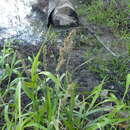Comprehensive Description
provided by North American Flora
Carex crus-corvi Shuttiw.; Kunze, Suppl. Riedgr 128. 1842; pi. 32. 1844.
Carex Crus-corvi f. orlhoclados Kunze, Suppl. Riedgr. 166, pi. 42. 1844. (Type from Louisiana.)
Carex Crus-corvi f. orthostachys Kunze, Suppl. Riedgr. 167. 1844. (Type from Illinois.)
Carex ornithorhyncha Engelm.; Kunze, Suppl. Riedgr. 167, as synonym. 1844.
Carex Hyslrix A. Gray; Kunze. Suppl. Riedgr. 167, as synonym. 1844.
Carex sicaeformis Boott, Bost. Jour. Nat. Hist. 5: 113. 1845. (Type from New Orleans, Louisiana.)
Carex Halei Dewey. Am. Jour. Sci. II. 2: 248. 1846. (Type from Louisiana.)
Cespitose, the rootstocks short-prolonged, tough, stout, black, fibrillose, the culms very stout, S-12 mm. thick at base, erect, 5-9 dm. high, light-brown at base, shorter than the leaves, sharply triangular with concave sides, the angles strongly serrulate and slightly winged; leaves with well-developed blades 5-8 to a culm, the blades erect-ascending, flat, light-green, very elongate. 3-7 dm. long, 5-10 mm. wide, serrulate on margins and roughened towards the apex, the sheaths septate-nodulose dorsally, and ventrally thin, strongly purplish-dotted, not crossrugulose and not thickened nor prolonged beyond base of blade at mouth, the ligule conspicuous, dark-margined, wider than long; spikes very numerous, in a compound terminal head 7-17 cm. long, 1.5-5 cm. thick, the lower branches often somewhat separate; separate spikes hardly distinguishable, the staminate flowers apical, inconspicuous, with the several to many ascending or spreading perigynia beneath; lower bract usually present, bristleform, 8 cm. long or less, sometimes wanting, the others, if present, short; scales lanceolate-triangular, thin, greenish or light-brownish-tinged, or soon hyaline, with 3-nerved green center, acuminate to aristate, 3-5 mm. long and narrower than the perigynia; perigynia plano-convex, 6-7 mm. long, yellowish or brownish in age, the body narrowly ovoid, the lower third turgid, disk-like, very spongy and subcoriaceous, 2.5-3 mm. long, 1-1.25 mm. wide, strongly nerved dorsally, obscurely nerved and sharp-margined ventrally, short-stipitate, truncate-cordate at base, and tapering into a serrulate slender beak 2-3 times length of body, dorsally cleft, deeply bidentate, the teeth subulate, slightly spreading; achenes lenticular, strongly ovate, rounded at the sbort-stipitate base, tapering above, slightly apiculate, 1.75 mm. long, 1 mm. wide; style slender, straight, somewhat enlarged at base, jointed with achene; stigmas two, lightreddish-brown, slender, short.
TTPS LOCALITY: New Orleans, Louisiana (Drummond 432).
Distribution: Swamps. Florida to Texas, and northward in the Mississippi Valley to southern Michigan, southern Minnesota, and eastern Nebraska. (Specimens examined from Michigan, Wisconsin. Indiana, Illinois, Minnesota, Iowa, Kentucky. Tennessee. Missouri, Kansas, Oklahoma, Arkansas. Texas. Louisiana, Mississippi, Georgia, Florida.)
Ii.i.i strations: Kunze, Suppl. Riedgr. /. 32. 42: Kritt. & Brown, 111. Fl. /. 824; ed. 2. /. 901; Rob. & Fern. Man. /. 413; Engler. Pflanzenrcich 4": 169. /. 27. M-Q; Boott, 111. Carex 25. pi. 65.
- bibliographic citation
- Kenneth Kent Mackenzie. 1931. (POALES); CYPERACEAE; CARICEAE. North American flora. vol 18(2). New York Botanical Garden, New York, NY

